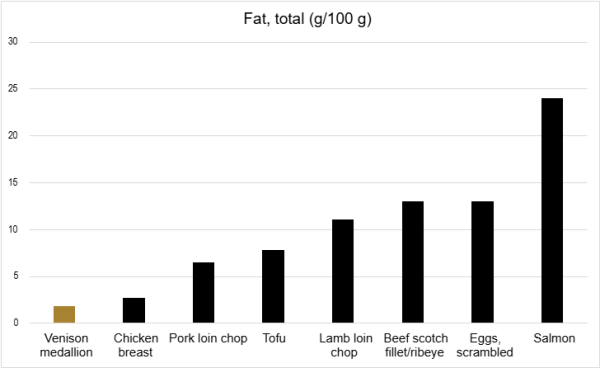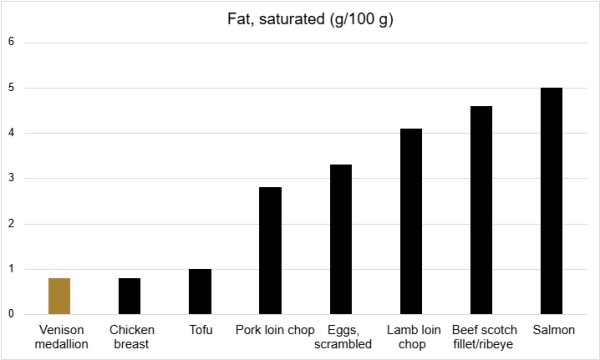Fat Facts: Understanding the Role of Fats in a Healthy Human Diet
For years, the word fat has been unfairly associated with poor health. But nutrition science tells a very different story — one that’s more about balance, quality, and source than elimination.
Fats are essential to human health. They provide energy, help the body absorb vitamins, support brain and hormone function, and form the structure of every cell in our body. The real question isn’t whether we should eat fat — it’s what kind of fat we should eat, and where it comes from.
That’s where grass-fed lean meats, such as venison, come into the picture. These meats contain beneficial fats in the right proportions, making them a valuable part of a balanced, modern diet.
The Essential Role of Fat in the Human Body
Fats are one of the three key macronutrients, alongside carbohydrates and protein. They deliver more than twice the energy of other nutrients — nine calories per gram — and perform several critical functions:
- Energy storage and metabolism: Fats provide long-term energy and support endurance.
- Hormone production: Many hormones, including sex hormones, are made from cholesterol and fatty acids.
- Vitamin absorption: Vitamins A, D, E, and K require fat for absorption.
- Cell structure: Every cell membrane in your body contains fats that keep it flexible and functional.
Put simply, fat isn’t something to fear — it’s something to manage wisely.

Source: The New Zealand Food Composition Database.
Saturated Fatty Acids: Misunderstood but Not the Enemy
For decades, saturated fats were blamed for heart disease. But modern research paints a more nuanced picture.
While excessive saturated fat from processed foods can contribute to health problems, moderate intakes from natural sources — like lean red meat, dairy, and eggs — can fit comfortably into a healthy diet.
The key lies in the source of the fat.
Grass-fed meats contain a unique fat profile compared with grain-fed meats:
- Lower total fat content: Venison, for example, typically contains only 1–2% fat, much less than most - commercial beef.
- Better fatty acid balance: Grass-fed animals have higher levels of omega-3 fatty acids and conjugated linoleic acid (CLA) — both linked to improved heart health and reduced inflammation.
- Higher-quality saturated fats: Naturally occurring saturated fats in pasture-raised meats come in forms that are easily metabolised and used for energy.
Unlike processed or hydrogenated fats, these natural saturated fatty acids do not significantly raise LDL (“bad”) cholesterol in most people — and they may help raise HDL (“good”) cholesterol instead.
When consumed as part of a balanced diet, lean, grass-fed red meats provide not only high-quality protein and micronutrients like iron, zinc, and B12, but also healthy, functional fats that support metabolism and hormone balance.

Source: The New Zealand Food Composition Database.
The Real Problem: Trans Fats
If one type of fat truly deserves its bad reputation, it’s trans fats. These are artificial fats created during hydrogenation — a process that turns liquid oils into solid fats for processed foods like pastries, margarine, and deep-fried snacks.
Trans fats interfere with the body’s natural fat metabolism and are strongly linked to heart disease, systemic inflammation, and insulin resistance. They:
- Increase LDL (“bad”) cholesterol.
- Decrease HDL (“good”) cholesterol.
- Promote inflammation in blood vessels.
In contrast, naturally occurring trans fats — such as the CLA (conjugated linoleic acid) found in small amounts in grass-fed beef and venison — are completely different.
CLA has been linked to positive outcomes such as improved immune function, reduced inflammation, and even healthier body composition. It’s a prime example of how the source and structure of a fat determine its effect on the body.
Why Grass-Fed Lean Meats Deserve a Place on the Plate
Grass-fed meats like venison offer a nutritional advantage that extends far beyond their protein content. Their fat composition — naturally lean, with a higher ratio of omega-3 to omega-6 fats and rich in CLA — makes them one of the healthiest red meat options available.
Venison, in particular, is:
- Exceptionally lean: Low total fat yet rich in essential fatty acids.
- Nutrient-dense: High in iron, zinc, selenium, and B vitamins.
- Sustainably raised: Pasture-fed animals naturally produce healthier fat profiles without additives or grain finishing.
When compared to grain-fed beef or processed meats, venison’s fat profile is distinctly more favourable for cardiovascular and metabolic health.
The Bottom Line
Fat is not the villain it was once made out to be. Instead, it’s an essential nutrient that fuels your body, supports your hormones, and keeps your cells healthy. The key is choosing fats from natural, minimally processed sources. By including grass-fed, lean red meats like venison in your diet — alongside fish, nuts, seeds, and plant oils — you’re getting the best of both worlds: The energy and structural benefits of healthy fats. The protein, vitamins, and minerals that only high-quality meat can provide. The next time you’re planning a balanced meal, don’t shy away from healthy fats — especially those found in naturally lean, pasture-raised meats. They’re not just good for you — they’re an essential part of a truly nutritious diet.

